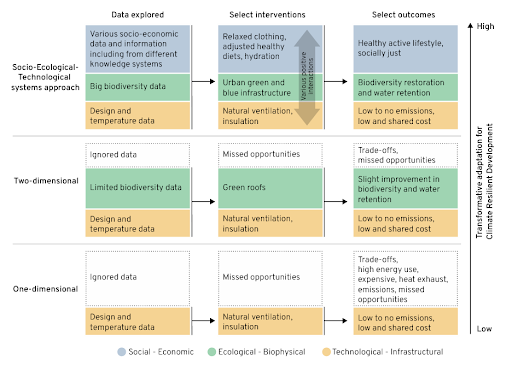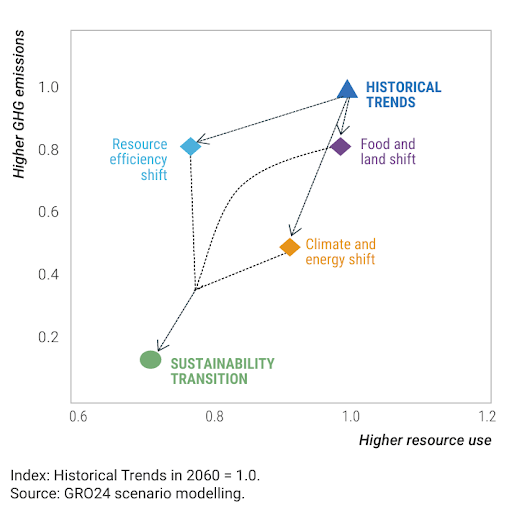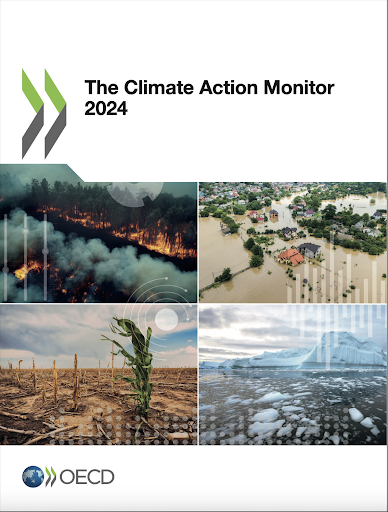
THEME OF THE FORTNIGHT
CLIMATE ACTION AND RESILIENCE
REPORTS
10 New Insights in Climate Science 2024/2025

Authors: Future Earth
Publication Details: Future Earth, The Earth League, The World Climate Research Programme, 2024.
The report is a collaborative effort by Future Earth, the Earth League, and the World Climate Research Programme, synthesises critical climate research published between January 2023 and June 2024, providing essential guidance for policymakers and society. This report highlights ten key findings, including the alarming surge in methane levels, the complex interplay between air pollution reduction and climate impacts, and the escalating threat of uninhabitable heat. It underscores the detrimental effects of climate extremes on health and raises concerns about the influence of a warming ocean on El Niño-Southern Oscillation and the Atlantic Meridional Overturning Circulation. The report also emphasised the importance of biocultural diversity in enhancing the Amazon's resilience, the growing vulnerability of critical infrastructure to climate hazards, and the need for new frameworks for climate-resilient urban development. It stresses the necessity of addressing governance gaps in the energy transition minerals value chain for just transitions and the critical role of perceived fairness in public acceptance of climate policies. For decision-makers, this report provides a concise overview of the latest climate science, enabling informed policy development and strategic planning to mitigate climate change impacts, adapt to evolving conditions, and facilitate a just and equitable transition to a sustainable future. Specifically, the report's insights into infrastructure vulnerabilities and urban resilience frameworks can directly inform climate action by guiding investments and policy decisions aimed at strengthening critical systems and fostering sustainable urban development.
Read More: https://doi.org/10.5281/zenodo.14035986
Global Resources Outlook 2024: Bend the Trend - Pathways to a Liveable Planet as Resource Use Spikes

Authors: United Nations Environment Programme
Publication Details: International Resource Panel. Nairobi, 2024.
The report addresses the urgent need for a global shift towards sustainable resource use to combat the triple planetary crisis of climate change—biodiversity loss, and pollution. The report highlights the alarming fact that global resource extraction has tripled in the past five decades, driven primarily by infrastructure development and high consumption patterns, especially in high-income countries. Projections indicate that without immediate and significant action, resource extraction could further increase by 60% by 2060, leading to even more severe environmental damage. However, the report emphasises that this outcome is not inevitable and that there is considerable potential to reverse these negative trends.
The report highlights significant concerns like, material use has increased more than three times over the last 50 years and continues to grow by an average of more than 2.3 per cent per year. Climate and biodiversity impacts from material extraction and processing greatly exceed targets associated with staying within 1.5 degrees of climate change and avoiding biodiversity loss. The report recommends the implementation of bold policy actions, including the phasing out of unsustainable practices, the promotion of responsible and innovative solutions across various sectors, and the creation of conditions that ensure social equity during the necessary transitions. It stresses the importance of integrating resource management into multilateral environmental agreements and establishing clear and sustainable resource use pathways. The report concludes that immediate and decisive action is crucial to achieving sustainable resource consumption and production patterns globally.
Read More: https://www.unep.org/resources/Global-Resource-Outlook-2024
The Adaptation Gap Report 2024

Authors: United Nations Environment Programme (UNEP)
Publication Details: United Nations Environment Programme. UNEP, 2024.
The Adaptation Gap Report 2024 highlights the urgent need for enhanced climate adaptation efforts, particularly in developing countries that are most vulnerable to climate impacts. The report emphasises the necessity for nations to adopt stronger adaptation components in their climate pledges and to commit to robust climate finance goals. It calls for increased investments in adaptation strategies to protect communities and ecosystems from the escalating effects of climate change. The report also underscores the importance of integrating adaptation measures into national policies and development plans to build resilience and ensure sustainable development.
Read More: https://www.unep.org/resources/adaptation-gap-report-2024
The Climate Action Monitor 2024

Authors: Organization for Economic Co-operation and Development (OECD)
Publication Details: OECD Publishing, 2024
The Climate Action Monitor 2024 provides a comprehensive evaluation of global climate action efforts, assessing progress towards net-zero targets and identifying major climate-related hazards. The report analyses key trends in climate policies and measures, offering insights into the effectiveness of current actions and highlighting areas requiring enhanced ambition. It serves as a valuable tool for policymakers, researchers, and stakeholders to track progress, identify gaps, and inform future climate strategies to accelerate the transition to a low-carbon, resilient future.
Read More: https://doi.org/10.1787/787786f6-en
RESEARCH PAPERS
Global Streetscapes - A comprehensive Dataset of 10 million Street-level Images Across 688 Cities for Urban Science and Analytics
Authors: Yujun Hou, Matias Quintana, Maxim Khomiakov, Winston Yap, Jiani Ouyang, Koichi Ito, Zeyu Wang, Tianhong Zhao, Filip Biljecki
Publication Details: ISPRS Journal of Photogrammetry and Remote Sensing, vol. 215, 2024
Street View Imagery (SVI) played a crucial role in analysing urban environments, benefiting fields such as urban morphology, health, greenery, and accessibility. Commercial services like Google Street View and crowdsourcing platforms such as Mapillary and KartaView provide billions of images globally. Despite their extensive coverage and quality, these images lacked detailed metadata, including weather, quality, and lighting conditions, limiting their suitability for specific analyses. To address these limitations, the paper introduced Global Streetscapes, a dataset comprising 10 million crowdsourced and free-to-use SVIs from 688 cities across 210 countries and territories, including Indian cities such as Bengaluru, Chennai, Delhi, Mumbai, and Kolkata. Representing around 10% of the global population, the dataset was the largest labelled collection of its kind, offering 346 attributes to characterise street photos. It contained geographical, temporal, and semantic information, along with ground truth labels for benchmarking computer vision models. This open-access dataset enabled large-scale, multi-city comparative studies and provided a framework for ongoing updates. It supported research in climate action planning by assessing green infrastructure, transportation, urban morphology, and climate vulnerabilities. The dataset and its associated code were publicly available on GitHub, facilitating further advancements in urban research
Post-Fifth Assessment Report Urban Climate Planning: Lessons from 278 Urban Climate Action Plans Released from 2015 to 2022
Authors: Prince Dacosta Aboagye, and Ayyoob Sharifi
Publication Details: Urban Climate, vol. 49, 2023.
Cities primarily addressed climate concerns through Climate Action Plans (CAPs). The IPCC Fifth Assessment Report (AR5) was the first to highlight urban climate change globally, yet there remained a lack of comprehensive analysis of CAPs adopted or published after AR5. This gap made it difficult to evaluate their strengths and weaknesses, limiting insights for future urban climate planning. This study conducted qualitative content analyses on CAPs from 278 cities worldwide, aiming to (1) examine their content and structure from 2015 to 2022 and (2) assess their alignment with best climate action practices. The findings revealed variations in CAP adoption across city types and regions. A notable increase in CAPs was observed during the COVID-19 lockdown period compared to pre- and post-lockdown phases. A shift was also noted from mitigation-focused CAPs before COP21 to plans incorporating both mitigation and adaptation strategies. Approximately 96% of CAPs prioritised the transport sector, yet 55% of mitigation-related CAPs lacked deep decarbonisation pledges. Cities with such pledges (81%) were more likely to report baseline emission inventories. Common shortcomings included a lack of inclusiveness, transparency, and integration. The study underscored the need for evidence-based planning to enhance future urban climate action.
Read More: https://doi.org/10.1016/j.uclim.2023.101550
Making Global Climate Action Work for Nature and People: Priorities for Race to Zero and Race to Resilience
Authors: Idil Boran , Nathalie Pettorelli, Alexandre C. Köberle , Ricardo Aguiar Borges , Adriana De Palma, Deborah Delgado, Andrew Deneault, Alexandra Deprez , Pablo Imbach, Neil R. Jennings, Anke Manuela Salzmann, Oscar Widerberg, Sander Chan
Publication Details: Environmental Science & Policy. 2024, pp. 123-135.
This report explores the integration of nature-based solutions into global climate action efforts, emphasising the importance of preserving and restoring ecosystems while mitigating climate change. It discusses how nature-positive strategies—such as reforestation, wetland restoration, and sustainable land management—can simultaneously address climate change and biodiversity loss. The report highlights the growing recognition of the synergies between climate mitigation and conservation, urging policymakers to adopt a holistic approach that integrates both environmental and social resilience. It presents case studies from various regions that have successfully implemented these solutions, demonstrating how they contribute to climate adaptation and long-term sustainability. The report also outlines the role of international cooperation, funding mechanisms, and policy frameworks in scaling up these solutions worldwide.
Read More: https://doi.org/10.1016/j.envsci.2024.103803
Climate Change and Resilience: Developmental Science Perspectives
Authors: Ann V. Sanson and Ann S. Masten
Publication Details: International Journal of Behavioral Development, 48(2), 93-102, 2023
This article examines the intersection between climate change and human development, with a specific focus on how climate disasters affect the physical, social, and psychological development of individuals. The paper explores how climate-induced disruptions, such as extreme weather events, can lead to significant developmental setbacks, especially among vulnerable populations, such as children and marginalised communities. Drawing from both developmental science and climate change studies, the authors discuss how exposure to climate-related disasters influences cognitive and emotional growth, and the potential long-term consequences for societal well-being. The article highlights the need for incorporating developmental science into climate resilience planning to better address the needs of affected populations and build stronger, more resilient communities.
Read More: https://doi.org/10.1177/01650254231186332
National Institute of Urban Affairs
1st Floor, Core 4B, India Habitat Centre, Lodhi Road, New Delhi -110003, India
Telephone: (011) 24634971, 24643576
Email: director@niua.org • Website: niua.in





